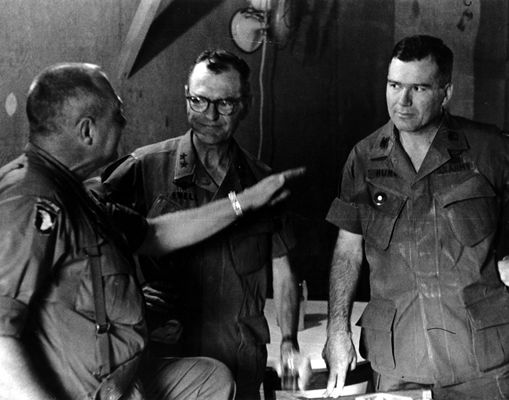
CHAPTER XIII
Overall Conclusions
This Monograph covers primarily the systematic blending of military judgment, data collection, and the simple problem-solving techniques as performed by the 9th Division and II Field Force, Vietnam in the period 1968 to 1970. We did not elaborate on the normal military decision-making methods which are well understood and which were utilized extensively in Vietnam. However, we have stressed the extension of these more normal decision-making devices by analytical methods. We have felt obliged to adhere to the standard military modus operandi, and, consequently, have drawn the following overall conclusions:
1. Normal military command and management techniques, aggressively pursued,
were adequate in Vietnam to keep military and pacification operations working
reasonably well. The "analytic approach" was a useful complementary technique.
2. The judicious use of operations analysis and analytical techniques when
melded with military judgment was quite effective in improving performance in
many areas of activity.
3. The 9th Infantry Division's analytical results-oriented efforts to
optimize resources and increase combat effectiveness (which had as a base the
goal to provide the maximum number of fit, motivated, well equipped and properly
supported infantry soldiers to the field on a daily basis, night and day)
worked.
4. The combination of the Constant Pressure concept, pacification, working
against the enemy system, and Vietnamization made the One-War concept a reality
and proved to be very effective tactically and strategically in the III Corps
Tactical Zone around Saigon in 1969 and early 1970.
5. Analysis worked best at division level; it was more difficult to apply
with precision at Field Force or Corps level.
6. The individual commander's ability, skill and knowledge transcended the
more tangible factors.
7. Innovation and changes in tactics had to be aggressively pursued while
continuing the optimization of ongoing operations which were well understood.
8. Many aspects of the situation resisted analysis.
[237]
THE AUTHORS LISTEN TO COLONEL GERACI
There is no doubt that the overall system described in this monograph worked. The $64 question is, why? Was it due to the way the war was developing in Vietnam at that particular time, or was it due to the use of combat analysis or to some other reason?
Most objective observers would agree that the Allied policies, strategy and grand tactics improved as the war went on. The improvements in the organization and effectiveness of the Government of Vietnam, the national mobilization of 1968 and thereafter, the increasing military pressure on the enemy system, and the accelerated pacification campaigns all contributed. Not all was done that should have been done, but for any imperfect world, the cumulative effect was one of impressive gains.
There was also a concurrent improvement and tightening up in the tactics and techniques utilized in Vietnam. As a body of doctrine solidified and was refined by battlefield experience, our operations became more effective.
Linked with the above was a definite deterioration in the strength and quality of the enemy units. The Viet Cong losses during Tet were substantial-in many areas the Viet Cong began to
[238]
disappear. As their combat requirements expanded and combat losses of the North Vietnamese began to accumulate, their experienced cadre became fewer and fewer. In the overall balance, their gross capability and their skill levels both declined.
A not inconsiderable factor in our favor was the high quality of the people involved. Down through the major level at least, practically every position was filled with top-notch people. These high quality leaders, from battalion level up, enabled us to come rapidly to grips with an unfamiliar type of war and to succeed.
The use of a system for coordinating all military and civil aspects of the struggle was widespread. However, in the III Corps Tactical Zone around Saigon, this system was elaborated and strengthened to a point that the One War concept became a reality in many areas. This focusing effect was very important.
A tremendous intensity of operations or concentration of effort was a factor. If one realizes that infantrymen were in the field about 100 hours a week and that units from battalion up were in operation 24 hours a day, seven days a week, the physical, mental and nervous demands on the commanders can be visualized. If one superimposed on this a tremendous will to damage the enemy and move the war in a favorable direction, substantial progress ensued. This intensity of effort had to be achieved and maintained at a very high level. Whether this intensity is feasible across the board is debatable.
The analytic approach helped to put all this together. Its concentration on results rather than activity was important. Its assistance in understanding the key aspects of complicated operations was valuable. Combat analysis helped to guide and control the myriad small engagements which added together meant progress.
A measured and rational development of combat analysis as a tool of command deserves emphasis in the future.
[239]
page updated 19 November 2002
Return to the Table of Contents